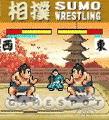Sumo wrestling hasn't yet hit the big time in America. Sure, one of the ancient Japanese sport's greatest modern champions, Akebono (aka Chad Rowan) hails from Hawaii--but there hasn't been any native-produced sumo games of note since Super Duper Sumos for the GBA, which was a jaunty Nickelodeon-inspired romp rather than a serious simulation. Sumo Wrestling from Mitsui and SWING, on the other hand, packs a lot of gameplay into its miniature sumo rings. Even the most culturally myopic gamer will appreciate its array of traditional sumo moves, reasonably intuitive controls, and detailed graphics.

For the uninitiated, a sumo match pits two enormous athletes in diaperlike garments ("mawashi" in Japanese) against one another in a rapid demonstration of basic mechanical laws, using girth and leverage to maneuver the opponent out of a small circular ring or throw the opponent to the ground before exhaustion sets in. Like all sports, there's a lot more to it than meets the eye: Sumo is not a simple wrestling match--it is a complex ceremonial edifice that has evolved over the 1,500-odd years since sumo's inception as a harvest ritual that covers everything from dietary guidelines to hairstyle. The mobile edition maintains a high level of this long-established etiquette, including the 10-tiered ranking system that ranges up to yokozuna (grand champion) and the prematch rice-tossing and clapping session; the referee is attired in a natty kimono and even makes the correct barking vocalizations to exhort the wrestlers to fight. Furthermore, your wrestler is customizable down to his mawashi color; if fire-engine red isn't getting the job done, you can always opt for a more intimidating greenish hue.
This level of superficial detail never goes amiss, and it's backed up by a comprehensive and well-documented wrestling system. Each wrestler is equipped with health and mental energy meters, which vary with the levels of punishment the wrestler has absorbed and administered, respectively. As the in-game help screens ably explain, a single match proceeds in three phases, each of which have a unique series of moves to perform: tachiai (beginning), koubou (middle), and kumi (grappling). In tachiai, the wrestlers come off their marks for the thunderous initial contact; koubou sees them maneuvering around the ring, slapping each other silly to rack up damage and build energy to go for a grapple; kumi is when a wrestler tops off his meter sufficiently to try a match-ending throw.
You can perform about four different moves in each phase, not including blocks and belt grabs. The blubber-rattling attacks are all straight out of the sumo handbook, and they include a wide selection of slaps, belly bops, head-butts, and elbow splashes, as well as some excellent throws. One of the more notable grapples lets you use your opponent's face as a handhold as you escort him to the ground. The majority of the moves are performed by pressing a direction key in tandem with the action button, which is a little awkward when you're trying to time an attack correctly. Fortunately, you can always resort to a basic slap by simply pressing the action key. The grappling system could use some additional work. Once you charge up and grab your opponent, two throw meters appear. If you can fill up your meter by jamming on the action key before your opponent can, you'll drop him and win the match; otherwise, your positions are reversed and you must defend yourself. Throwing your opponent is pretty trivial up until the last four levels on hard mode, rarely requiring even three-quarters of an effort on the action key. Sumo matches aren't really supposed to last long, but this aspect of the game feels a little unbalanced in that you usually win every match in the exact same manner; being able to push an opponent out of the ring or slap him into submission once in a while would be cool.
Still, Sumo Wrestling is an eye-catching game, featuring excellent, cartoony animation and 10 different rings to wrestle in, all of which have beautiful backgrounds. Altogether, Sumo does a good job of mobilizing this titanic contest and making it an enduring play.